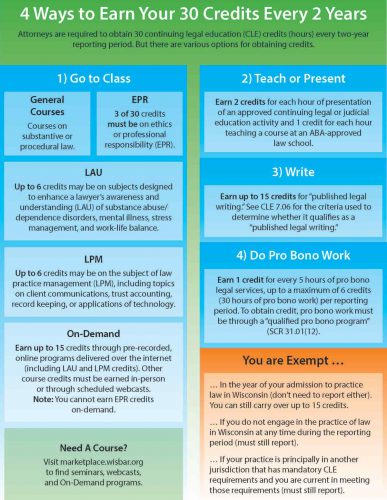
Can CLE resources do double duty?
Is there a way to squeeze an enormous amount of additional value from Continuing Legal Education (CLEs)?
Absolutely.
It’s doable but it requires a few important factors.
It depends primarily on your goals and the objectives you’re attempting to reach at your firm. In this post, I’ll share some non-traditional resources, strategies and tactics you can use to squeeze additional value from your CLEs.
Creating leverage with these 2019 CLE resource strategies
Most attorneys take the usual route.
They complete legal training that’s presented by experienced attorneys and/or an accredited source. Their education is typically in-person or on-demand. Which is absolutely something you should continue to do.
Knowledge = competitive advantage.
However, this isn’t the only way an attorney can meet their CLE requirements. Here are a few ideas worth pursuing in 2019. You’ll need to verify that these resources/strategies are allowed in your state and local area (obviously).
Let’s dive in.
Resource #1: Speaking and teaching attorneys
If you’re an experienced attorney, you may want to consider speaking and/or teaching. Certain jurisdictions allow you to earn CLE credits by speaking and teaching in a variety of accredited institutions.
What kind of institutions?
You can speak and/or teach a CLE course via an accredited teaching center, law school, university, college or community college.
Resources to pursue
Consider pursuing opportunities with:
- Law schools in your state/region (start with your alma mater)
- Online/distance teaching via in-state, out of reach schools
- Universities
- Colleges
- Community colleges
Then parlay your experience into larger speaking and teaching engagements you use to attract a large pool of clients all at once.
Resource #2: Write for attorneys
You may be able to earn CLE credits for legal research-based writing. The definition of published legal writing varies based on jurisdiction. As does the benefits. Many jurisdictions require that your writing meet a specific set of guidelines.
- It should contribute substantially to the continuing legal education of other attorneys
- It is original content you’ve written for attorneys, that’s published or accepted for publication
- Credits are typically given for each hour of research and writing with a cap on the number of credits offered
- Many jurisdictions also offer credits for updates and revisions made to previous articles (typically no credit for edits)
- This is typically available to experienced attorneys who have practiced law for a specific period of time (e.g. 24 months)
Resources to pursue
You’ll want to target publications that meet specific criteria.
- Publications with authority. The ABA Journal, National Law Journal and com are all authoritative publications. Authoritative publications boost your value and prestige, providing you with a greater amount of influence and reach.
- Publications with traffic. Publications like The American Lawyer, Law Technology Today and Trial Magazine are great examples of popular, high traffic, attorney-focused publications.
- Publications with opportunity. These are specialty publications that provide you with opportunities to win new business. In house counsel publications such as ACC Docket and Inside Counsel and are key examples.
Writing is a fantastic opportunity because it:
- Provides you with key opportunities to earn a substantial amount of your CLE credit
- Borrows the trust, influence and authority from key publications and makes it your own
- Simultaneously attracts new business, builds authority and positions yourself (and your firm) as influencers
- Creates a substantial amount of influence power and reach
- Provides substantial career opportunities with other like-minded firms and professionals
Is this it though?
This doesn’t sound all that compelling. Looks can be deceiving though.
Here’s why these strategies are so compelling
The benefits are outstanding. In the right hands, they’re sure-fire ways to catapult your expertise (and your firm) past your peers into the upper echelon of legal talent.
Here’s how these strategies create enormous leverage.
- Authority: The format of writing, teaching and speaking sets you apart. If you’re able to provide students, attorneys and legal professionals with value you build authority automatically. These tasks give you a significant amount of power, turning you into a sought after thought leader and influencer. This opens doors for…
- Networking: Writing, teaching and speaking, when used well, turns you into a super maven, connector or persuader. You’re able to rapidly build relationships with powerful influencers, administrators, gatekeepers, kingmakers and attorneys in other firms. Want to connect with a powerful and well-known influencer in the industry? Just interview them!
- Recruiting: You’re able to find and connect with promising talent. These could be graduates who you perceive to be a good culture and character fit for the firm. It could be freelancers who are hungry for opportunity and looking for work. Potential partners and an opportunity for mutual benefit.
- Intelligence: If you’re successful in your role as a speaker/teacher, your students will want to share their stories. This provides you with an incredible amount of intelligence. Shifts in the Overton Window, changes in thinking, etc. Writing, speaking and teaching place your fingers on the pulse of the industry. Do enough of it and you’ll have a keen sense of the mindset, desires, goals and fears of your audience.
- Rainmaking: Good networking, recruiting and intelligence produce new opportunities. If you’re even average at writing, speaking and teaching you should be able to use your experience to leapfrog onto new (non-CLE) speaking and teaching opportunities. Make a note of your experience as a writer, speaker or teacher and you can use it to pitch a prestigious publication or venue for writing, teaching and speaking engagements. If you’re a corporate attorney, use your experience to pitch speaking events that consistently place you in front of entrepreneurs (e.g. writing for Forbes, Wall Street Journal or the Washington Post speaking at corporate events, entrepreneur and startup clubs in your state). Create a marketing funnel and you have a consistent and never-ending supply of leads, clients and
- Careering: Depending on your jurisdiction, these strategies provide you with a massive jump on your CLE requirements. But they also place you far ahead of your peers. Clients are naturally drawn to authoritative influencers and thought leaders. If you’re a partner or associate at your firm, this strengthens your negotiating position. Losing you could be a costly proposition. These strategies provide you with the tools you need to negotiate an above-average salary, benefits and/or incentives.
We haven’t even begun to scratch the surface here.
CLE is a blessing in disguise
It’s often viewed as a tedious affair that takes attorneys away from important work. In reality, it’s actually the opposite.
CLE resources can do double duty.
You can use these CLE requirements to create an enormous amount of additional value – for yourself and your firm. It depends on your goals and the objectives you’re attempting to reach but it can be done.
As long as you see CLEs for what they are.
An opportunity.
With the right approach and a clear strategy to follow you can parlay your CLE requirements into the business development resource you’ve always wanted.






